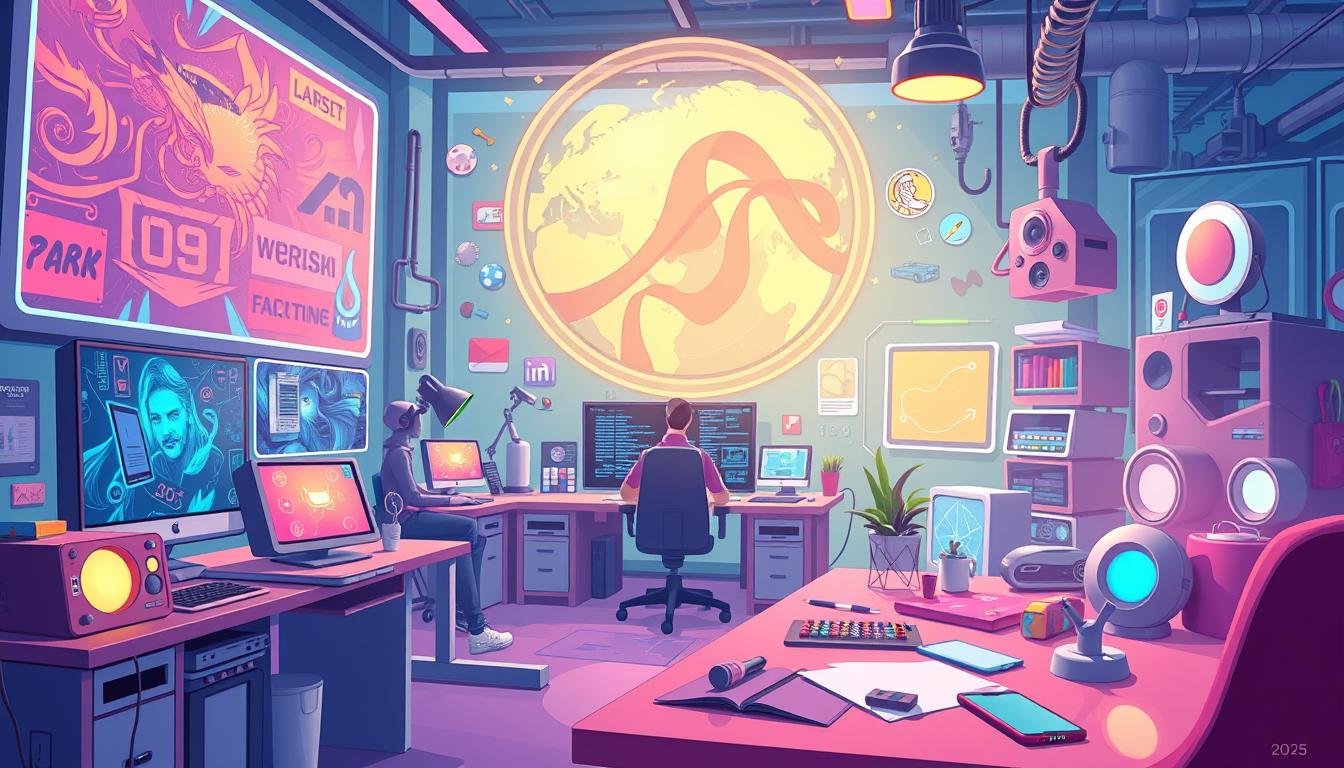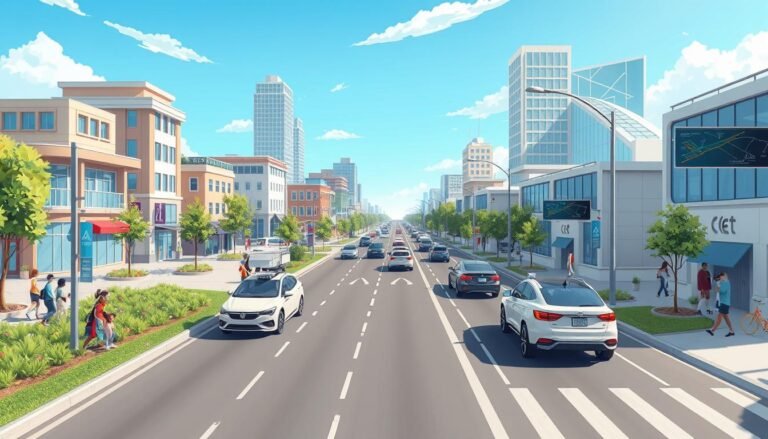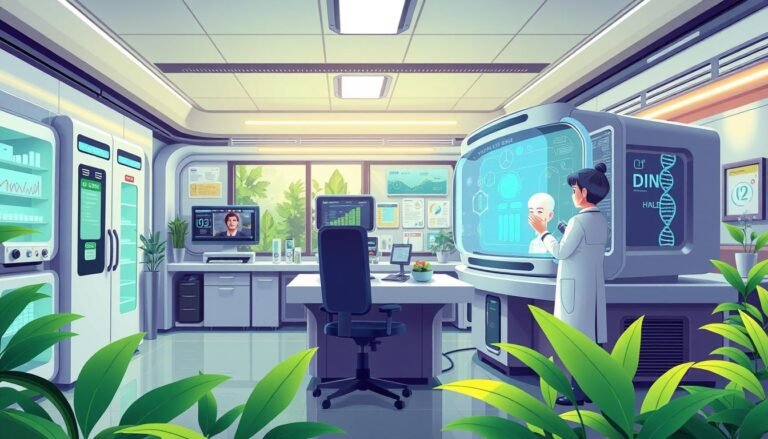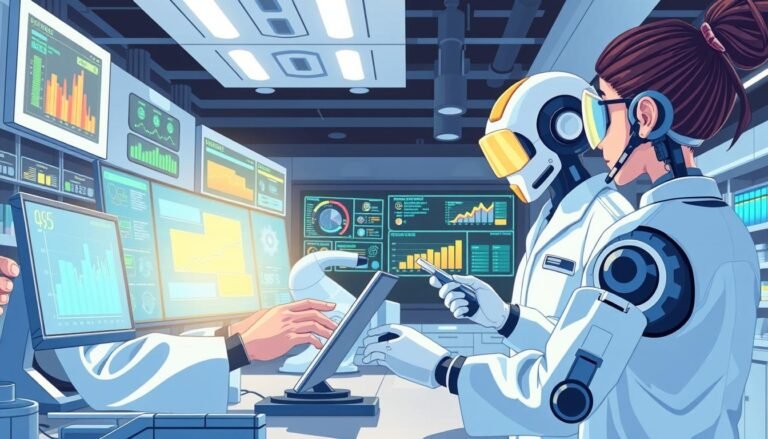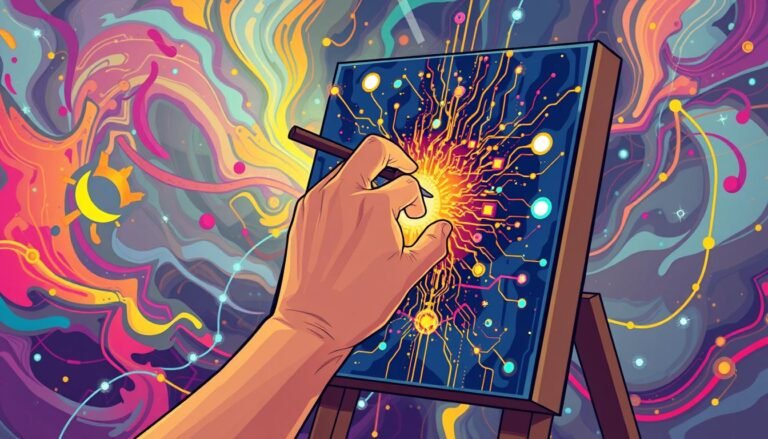The Impact of Generative AI on Creativity and Productivity in 2025
Will generative AI change the future of creativity and productivity, or is it just a trend? By 2025, generative AI could change how we work and create. It could add $2.6 trillion to $4.4 trillion to the global economy each year. This is a 15 to 40 percent boost from all AI technologies.
Imagine a world where 60 to 70 percent of jobs could be done by AI. This could change industries like banking, tech, and life sciences. AI not only makes work faster but also helps artists and writers create new things.
The U.S. is set to spend over $67 million on generative AI by 2025. This is more than the global average of $47 million. The U.S. sees AI’s potential in creative fields, which could grow from $1.7 billion in 2022 to $21.6 billion by 2032. Companies are excited about AI’s ability to make products more personal and work more efficient.
Key Takeaways
- Generative AI is projected to add $2.6 to $4.4 trillion annually to the global economy by 2025.
- 60 to 70 percent of employees’ work activities could be automated, enhancing productivity.
- The U.S. plans to invest over $67 million in generative AI implementation by 2025.
- The market for generative AI in creative industries is forecasted to reach $21.6 billion by 2032.
- Generative AI’s advancements pave the way for hyper-personalized consumer experiences and increased economic value.
Introduction to Generative AI: A 2025 Outlook
Looking ahead to 2025, generative AI is at the forefront. These systems can create content or solve problems on their own. They learn from vast amounts of data. From GPT-3 to GPT-4, AI has made huge strides, changing the future of technology.
Defining Generative AI
Generative AI systems are designed to create content or solve complex problems. They use big data and need little human help. They can write essays, code, and even make music or art.
goes beyond mimicking humans. It explores new creative and productive areas.
Current State and Growth Projections
From 2021 to 2025, AI growth is impressive. In 2021, 5% of companies used AI in development and testing. By 2025, this number will jump to 30%.
By 2026, generative design AI will handle 60% of new website and app designs. This shows a big increase in automation.
By 2026, over 100 million people will work with AI “robocolleagues.” By 2027, AI will automatically create nearly 15% of new apps. These trends show generative AI’s power to change industries like content creation and customer service.
| Year | Projected AI Impact | Percentage/Numbers |
|---|---|---|
| 2025 | Enterprises with AI-augmented development | 30% |
| 2026 | Design efforts automated by generative AI | 60% |
| 2026 | People working with AI-powered tools | 100 million |
| 2027 | Applications generated by AI | 15% |
As AI systems improve, they will become more independent and efficient. We expect major tech and societal changes. Generative AI will help solve problems and create content, moving us closer to artificial general intelligence (AGI).
The Democratization of AI Tools
The way we use AI is changing fast. Now, more people can use AI, even if they’re not tech experts. This means advanced tech is not just for big companies or experts anymore.
AI Accessibility for Non-Technical Users
More people without tech skills are using AI. Thanks to easy-to-use tools, anyone can tap into AI’s power. Generative AI, for example, makes it simpler to bring ideas to life.
This change is big. Gartner says over 80% of software makers will add GenAI by 2026. Today, it’s less than 5%.
Investment Trends and Predictions
More money is going into making AI easier to use. Investors want AI that’s simple for everyone. This money is helping create new tools that help us think better and innovate.
AI is becoming a big part of our work and life. It makes things better, helps us work together, and lets us explore new ideas. As AI gets more accessible, we’ll see even more amazing things happen.
Hyper-Personalization in Consumer Experiences
Generative AI is changing how we experience things by making everything more personal. It uses tools like Generative Adversarial Networks (GANs) and transformers. This lets companies give us what we want, right when we want it. We’ll look at how real-time personalization works and see examples from big companies.
Real-Time Personalization Technologies
AI makes our online experiences unique and dynamic. It starts with analyzing our data. This includes what we buy and what we look at online. This way, AI can tailor things just for us, making marketing and customer service better.
Companies like Netflix and Spotify are leading the way. Netflix suggests shows based on what we watch. Spotify makes playlists that fit our tastes in real-time. This changes how we use digital services.
Case Studies from Leading Companies
Big names show how AI makes experiences better. Michaels Stores saw a big jump in sales by making emails personal. This shows how AI can boost engagement and sales.
In entertainment, Netflix and Spotify are using AI to improve what we see and hear. Netflix makes video previews that keep us watching. Spotify creates playlists that match our tastes, making us happier with our music choices.
Retailers like Sephora and L’Oréal are also using AI. Sephora lets us try makeup virtually. L’Oréal uses AI to find new trends in online comments. This makes shopping and product development better.
AI’s role goes beyond entertainment and retail. The New York Times uses AI to give us news that’s just for us. This makes us more interested in what we read.
The future of AI in personalizing our experiences looks bright. With more IoT and better natural language processing, we’ll see even more tailored experiences. This will make our online lives even better.
The Impact of Generative AI on Creativity and Productivity
Generative AI is changing how we think about creativity and productivity. A 2023 Adobe survey found that 75% of creative professionals think AI will change their work a lot in the next five years. Already, 39% of creatives are using AI tools in their work. These tools help with tasks and spark new ideas that were hard to imagine before.
A designer used Midjourney AI to make patterns for 3D-printed clothes. They came up with 500 unique design ideas in just five hours. This shows how AI can boost creativity, leading to many new ideas.
AI models like GPT-3 and Stable Diffusion can turn simple text into detailed essays and images. They are very helpful in creative fields.
AI and human creativity work well together. They can make new things happen. It’s like comparing AI to Leonardo da Vinci, showing how AI can help us create more.
AI also helps in business, making things more efficient. For example, jobs like credit authorizers can automate up to 80% of their tasks. This lets people focus on more important work, making things better.
The Future of Jobs Report 2023 talks about new jobs like AI developers and AI content creators. These jobs show how important AI is in business. Companies need to help workers learn new skills to keep up with AI.
| Category | AI Impact | Human Contribution |
|---|---|---|
| Creative Professional | 500 designs in 5 hours | Idea conceptualization |
| Occupations (Clerks, Checkers) | 80% tasks automated | Strategic reallocation |
| New Job Roles | AI Developers, AI Content Creators | Skills adaptation |
This mix of AI and human creativity leads to better productivity. By working with AI, people can do more than they thought possible. This creates a future where we can be more creative and efficient.
Revolutionizing Creative Industries
AI is changing how we make and see content. Tools like ChatGPT help creators get past old blocks and work better. This is true in marketing and entertainment.
Transformations in Content Creation
Generative AI tools are changing how we create. They let creators try new things fast. This is changing how we make content.
- Generative AI models help creators get past blocks and work better.
- AI tools like ChatGPT give content on the fly to boost creativity.
- Custom GPT models help users make content that fits their vision.
In digital content, AI makes making different materials easy. This includes articles, blog posts, and marketing copy. It makes work faster and sparks new ideas.
AI also helps in design by making brainstorming easier. Designers can try out many ideas quickly. This helps them come up with and test new designs.
Market Growth Statistics
The AI arts market is growing fast. By 2032, the need for AI content will grow a lot. This is because people want new and quick ways to make content.
| Creative Field | Impact of Generative AI |
|---|---|
| Marketing | More work done and new marketing ideas |
| Visual Arts | Quick idea making and trying new styles |
| Music and Entertainment | New songs and faster making processes |
| Streaming Platforms | Content that fits you better, making watching more fun |
AI and creativity are working together well. This mix is making work better and opening up new areas for creativity.
AI-Augmented Workplaces
AI technology is growing fast, making AI-augmented workplaces common. These places mix human creativity with machine efficiency. This creates a hybrid workforce that uses AI to boost productivity and innovation.
The Hybrid Workforce: Humans and Machines
In a hybrid workforce, humans and machines work together to get better results. Studies show that generative AI can make a skilled worker 40% better than without it. AI can help humans by reducing mistakes and finding new solutions.
For example, AI has made cancer detection much more accurate. It helps doctors by using their skills and experience better.
But, using AI for the wrong tasks can make things worse by 19%. So, it’s key to use AI for specific tasks. When employees learn to use AI well, they can do their jobs 42.5% better.
Upskilling and Reskilling for AI Integration
AI in the workplace means workers need to keep learning new AI skills. Upskilling and reskilling are important to get ready for AI roles. Using GPT-4, workers in the lower skill range saw a 43% boost in performance.
Also, 57% of CEOs and CFOs want to use more AI and automation. As work changes, companies need to invest in training to fill skill gaps.
When adding AI, consider design, training, and how roles change. These steps help humans and machines work together well. This way, the hybrid workforce can reach its full potential.
Ethical Challenges and Regulations
Generative AI technologies like GANs, VAEs, and transformers are growing fast. They raise big ethical questions about their impact on society. With new uses in art and text, we need strong AI ethics and AI regulation more than ever.
Addressing Misinformation and Deepfakes
Dealing with deepfakes and misinformation is a big challenge. Deepfake tech, powered by AI, can make fake content that looks real. This can trick people and harm trust in media, affecting democracy.
Artists like Jason M. Allen have faced criticism for using AI in art contests. The theft of copyrighted material for AI training has also led to legal battles, like the lawsuit against Midjourney and Stable Diffusion in January 2023.
Global Regulatory Landscape
The world is working on rules to keep AI innovation safe and ethical. The European Union’s AI Act is a key effort. It sets rules for AI use while encouraging responsible innovation.
In the UK, a 2023 Supreme Court ruling on AI and patents shows ongoing debates. Nightshade, an AI model from the University of Chicago, fights back against other AI systems. It does this by messing with their training data, enforcing ethics.
Legal fights, like The New York Times’ criticism of OpenAI and Microsoft, show the battle to protect data and ideas from AI misuse. While rules might limit AI, they aim to make sure it’s fair and doesn’t harm society. By combining rules with ethics, we can make AI that’s good for everyone.
Conclusion
As we approach 2025, AI’s future is looking bright. It’s changing how we live and work in big ways. Generative AI tools are making industries better and helping us be more productive.
AI has opened doors for creatives and businesses. It’s helping artists and companies make more and better work. But, there are still hurdles to overcome, like getting different systems to work together.
AI is being used in amazing ways, like making Tom Hanks look younger in movies. It’s also helping with education, like Amira Learning’s smart tutoring. But, we must use AI wisely and follow the rules.
It’s important for companies to be ready for AI. They need good plans and to understand how to use it right. This way, AI can help us grow and be more creative without causing problems.
Looking ahead, AI is set to bring big changes. With careful planning, it can help us achieve great things. So, let’s embrace AI’s potential and make a better future together.
Source Links
- The economic potential of generative AI: The next productivity frontier
- Council Post: The Future Of Generative AI: What To Expect In 2025
- The Future of Generative AI: A Multi-Year Outlook
- Generative AI, the American worker, and the future of work
- How Generative AI Can Augment Human Creativity
- Democratized Generative AI: What’s Behind Creative Accessibility for All?
- Generative AI for Hyper-Personalization: Transforming Customer Experiences
- How generative AI can boost consumer marketing
- Generative AI is Transforming Personalization
- AI and Creativity: The Impact of Generative AI on Human Creativity | Team-GPT
- Generative AI Can Impact Jobs By Enhancing Creativity And Productivity
- Does Generative AI aid or homogenize human creativity?
- The Influence of Generative AI on Creative Industries
- The impact of generative AI in the Creative Industry
- How generative AI can boost highly skilled workers’ productivity | MIT Sloan
- Navigating the impact of generative AI in the world of work
- Reshaping Jobs and Workflows: The Impact of Generative AI
- Generative AI Ethics: 8 Biggest Concerns and Risks
- The Ethical Implications of AI on Creative Professionals
- Ethical Challenges and Solutions of Generative AI: An Interdisciplinary Perspective
- Council Post: How Generative AI Can Improve Employee Productivity And Happiness
- The Impact of Generative AI – Jan Kirenz

